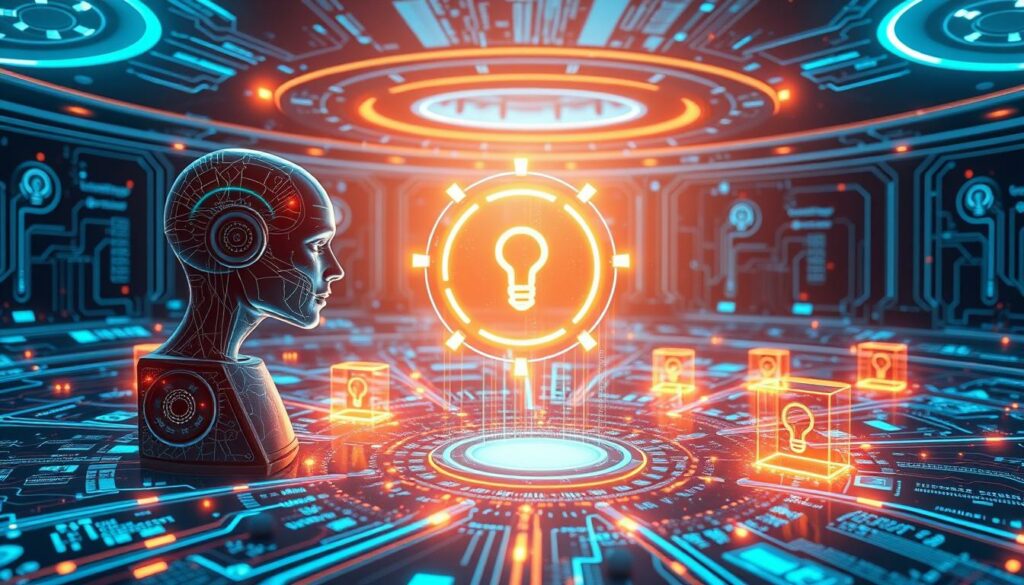Did you know ransomware attacks on industrial organizations have jumped by 50% each year? This shows how crucial it is to have strong cybersecurity. As cyber threats get more complex and common, companies need new ways to protect their important data.
Artificial Intelligence (AI) and Machine Learning are leading this change. They’re not just buzzwords; they’re changing how companies fight against cyber threats. By using these technologies, companies can improve their defenses, automate how they find and respond to threats, and stay ahead of dangers.
The Dragos Platform is a great example. It was named a Market Leader in OT Security and won the Best Industrial Security Solution by SC Awards in 2023. This shows how important AI and Machine Learning are in making cybersecurity stronger in different areas.
With 61% of companies finding it hard to watch over their important assets, AI-driven solutions are key. In this new era, combining AI, Machine Learning, and cybersecurity is crucial. It’s not just helpful; it’s necessary for managing and responding to threats well.
Key Takeaways
- The rise of ransomware attacks highlights urgent cybersecurity needs.
- AI and Machine Learning are reshaping how organizations approach cyber defense.
- Automated response mechanisms can significantly bolster threat management.
- The Dragos Platform exemplifies successful AI implementation in industrial cybersecurity.
- Effective monitoring and defense strategies are critical in today’s digital landscape.
Introduction to AI and Machine Learning in Cybersecurity
The world of cybersecurity is changing fast, thanks to new AI and machine learning. It’s key to understand how these technologies work together to protect us from cyber threats. They help create strong defenses against different kinds of attacks.
AI in cybersecurity is growing fast, expected to jump from USD 14.9 million in 2023 to USD 118.9 million by 2030. That’s a growth rate of 27.8% each year. As more companies use cybersecurity technology, the need for AI solutions is growing quickly.
Big names like Check Point, Crowdstrike, FireEye, and Palo Alto Networks are leading the way. They’re making advanced AI systems that make security better. These systems use machine learning to look through lots of data fast. They can spot and tackle threats right away. The use of machine learning in cybersecurity is changing how we fight threats by learning from past attacks to predict future ones.
For companies wanting to improve their security, AI and machine learning are a powerful team. They give deep insights by analyzing data. This helps spot patterns that could mean a security issue. Groups like the U.S. AI Safety Institute are working on making sure AI is used responsibly.
As cyber threats get more complex, knowing about AI in cybersecurity is crucial. Adding these technologies to current security plans can make them stronger. This helps companies stay one step ahead of threats. How well companies use these technologies will affect their security.
| Market Size (2023) | Projected Market Size (2030) | Expected CAGR |
|---|---|---|
| USD 14.9 million | USD 118.9 million | 27.8% |
Getting ready for the future means getting involved with AI. Using cybersecurity technology with machine learning can help protect important info and keep things running smoothly.
The Growing Importance of Cybersecurity
The threat landscape is changing fast, bringing new challenges for businesses and people. Every day, companies face threats like data breaches, ransomware attacks, and identity theft. It’s more important than ever to understand the importance of cybersecurity. With hackers getting smarter, not having good digital security can lead to big problems.
Recent reports show the rising costs of data breaches. The 2023 Cost of a Data Breach report says companies could lose millions and suffer from bad reputations. This shows how vital digital security needs are in a world where one weak spot can cause huge issues.
About 55% of companies are hesitant to use some AI tools because of data worries. Digital security needs are key as leaders and IT teams deal with this complex situation. Also, while 37% of businesses want to hire more people for tech needs, only 26% have made generative AI a part of their rules.
In conclusion, cybersecurity is key to protecting companies and keeping customers’ trust. With the right steps, you can beat threats and adapt to the threat landscape‘s changes.
What is Machine Learning?
Machine learning is about making computers learn from data to make predictions. It’s a big part of artificial intelligence and helps in many areas, like cybersecurity. It works by looking at lots of data, finding patterns, and making better decisions.
It’s important to know the main types of machine learning. There are three main kinds:
- Supervised Learning: This type trains algorithms on labeled data. They learn from examples and predict on new data.
- Unsupervised Learning: Here, algorithms look at unlabeled data to find patterns. It’s great for grouping similar things together.
- Reinforcement Learning: This method teaches algorithms by giving rewards or penalties for actions. It’s a way of learning by trying different things.
In cybersecurity, these machine learning types help find security threats. They make it easier to spot problems and keep data safe. This helps protect important information and keep systems running smoothly.
| Type of Machine Learning | Definition | Application in Cybersecurity |
|---|---|---|
| Supervised Learning | Learning from labeled data for predicting outcomes. | Identifying known threats through historical attack data. |
| Unsupervised Learning | Analyzing unlabeled data to find hidden patterns. | Detecting unusual behavior patterns that may signify attacks. |
| Reinforcement Learning | Learning optimal strategies through trial and error. | Improving responses to security incidents based on past experiences. |
Understanding machine learning and its types shows how it can change cybersecurity. By using these advanced methods, companies can keep up with new threats. This helps protect their digital worlds better.
How AI Enhances Cyber Defense
AI is changing how we protect against cyber threats. It’s key in detecting threats and automating cybersecurity. This helps businesses find strong ways to keep their systems safe.
Predictive Analytics in Threat Detection
Predictive analytics looks at past data to spot threats early. This helps organizations act fast to protect themselves. AI can see trends that might lead to attacks, making it better at detecting threats.
Automated Response Systems
Automated response systems are changing cyber defense. They let companies act quickly when there’s a security issue, stopping problems before they get worse. With AI, these systems can quickly fix issues and keep things running smoothly.

| Feature | Predictive Analytics | Automated Response |
|---|---|---|
| Function | Identifies potential threats through data patterns | Responds to threats in real time |
| Speed | Reduces response time | Instantaneous reaction |
| Focus | Proactive threat prediction | Incident mitigation |
| Impact | Strengthens overall defense | Mantains operational integrity |
Using these methods makes security better and builds trust in an organization. As threats keep changing, AI’s role in defense is more important than ever.
AI and Cyber Defense: Benefits and Challenges
As cybersecurity changes, knowing how AI helps in cybersecurity is key. AI makes things more efficient, helping protect against new threats. It looks at huge amounts of data fast, spotting attacks early, which is a big step forward in cyber defense improvement.
Automation is another big plus. AI makes responding to cyber-attacks quick and accurate. This lets your team focus on stopping and fixing problems fast, reducing damage. It also automates tasks like updating systems, which cuts down on work and mistakes.
But, there are still challenges with using AI. One big worry is keeping data safe. AI looks at a lot of information, so protecting sensitive data is crucial. It’s also important to avoid biases in AI, which can lead to missing threats or false alarms. And, adding AI to current systems can be tricky.
AI also brings new risks in cyber threats. For example, hackers use AI-powered malware and find vulnerabilities automatically. Deepfake tech makes it hard to tell real from fake, and AI can make phishing emails look real. This makes it harder for businesses to stay safe.
To use AI well, being careful is important. Using ethical AI practices helps avoid risks and use AI for defense. Finding the right balance between the benefits of AI in cybersecurity and its challenges is crucial for lasting protection in our digital world.
| Benefits of AI in Cybersecurity | Challenges of AI Deployment |
|---|---|
| Enhanced efficiency in threat detection | Data privacy concerns |
| Rapid incident response capabilities | Algorithmic biases |
| Automation of routine security tasks | Complex integration into existing systems |
| Advanced behavioral analytics for user profiles | Emergence of AI-powered cyber threats |
The Role of Data in Machine Learning for Cybersecurity
In cybersecurity, data is key to machine learning. It’s the foundation for AI models that keep our information safe. For those wanting to boost their defenses, knowing how data drives cybersecurity is vital.
Big Data and Its Impact
Big data is crucial for your cybersecurity plan. It gives deep insights into possible weak spots. By analyzing user actions, transaction records, and threat data, you can spot patterns missed by traditional methods. Machine learning needs lots of data to work well, meeting the AI’s needs for strong security.
Using big data analytics helps spot the effects of different threats and improve how you handle cyber attacks. Generative AI takes this further, helping find new threats and boost security even more.
Here’s a table showing the key data types for training machine learning in cybersecurity:
| Data Type | Description | Importance in Machine Learning |
|---|---|---|
| User Behavior Analytics | Data from how users act in a system. | Creates profiles of normal behavior, spots oddities. |
| Transaction Records | Logs of accessing and interacting with sensitive data. | Key for catching fraud and protecting sensitive info. |
| Threat Intelligence Feeds | Up-to-date info on new cybersecurity threats. | Helps quickly update security to fight new attacks. |
| System Vulnerability Reports | Details of known weaknesses in software or hardware. | Supports taking proactive steps based on known risks. |
With new cyber threats, like those from generative AI, data’s role in machine learning is more important than ever. To tackle challenges like convincing phishing and adaptable malware, strong data management and ongoing checks are key. Combining big data with advanced machine learning boosts your cybersecurity a lot. For more on this, see this article on oil and gas security.

Machine Learning Algorithms Used in Cyber Defense
In the fast-changing world of cybersecurity, using advanced machine learning algorithms is key. These algorithms help protect organizations by finding and stopping threats early. Each algorithm has special strengths that improve security.
Common machine learning algorithms in cybersecurity include:
- Decision Trees: These break down complex decisions into simpler parts.
- Neural Networks: Great at recognizing patterns, they spot unusual signs of cyber threats.
- Clustering Algorithms: Group similar data to find odd patterns that could mean a security issue.
- Ensemble Methods: Combine many algorithms’ predictions to increase accuracy and lower the chance of mistakes.
These algorithms help create AI applications that learn from new data. They adapt to new cyber threats. For instance, a study in the Sensors journal talked about effective algorithms like Support Vector Machines (SVM), Random Forest, and Naïve Bayes. Each method uses different ways to pick the best features for better performance.
By 2025, cybercrimes could cost USD 10.5 trillion. So, investing in strong machine learning algorithms is crucial. Knowing how these algorithms work helps in better threat detection and response.
| Algorithm | Application | Strengths |
|---|---|---|
| Decision Trees | Classification | Clear interpretation of decisions |
| Neural Networks | Pattern Recognition | Highly effective for complex data |
| Clustering | Anomaly Detection | Identifies data outliers |
| Ensemble Methods | Combined Predictions | Increased accuracy and robustness |
As security needs get more complex, using these machine learning algorithms is vital. They help protect sensitive info and keep organizations safe from cyber threats.
Case Studies: Successful AI Implementations
Real-world examples show how AI changes cybersecurity for the better. Companies like IBM, CrowdStrike, and Darktrace lead the way. They use AI to fight threats and make things run smoother.
Notable Examples from Industry Leaders
IBM uses AI to manage cybersecurity risks. It looks at lots of data from different places. This helps spot threats early and deal with them fast. This makes IBM stronger against cyber attacks.
CrowdStrike’s AI helps teams act fast when something goes wrong. This cuts down on how long it takes to respond. It also helps make digital spaces safer. Looking at these AI success stories shows how AI can really improve cybersecurity.
FAQ
How does AI and machine learning enhance cybersecurity?
AI and machine learning make cybersecurity better by automatically finding threats and speeding up responses. They also predict attacks before they happen. This helps protect organizations and deal with threats quickly.
What types of machine learning are used in cybersecurity?
Cybersecurity uses three main types of machine learning: supervised, unsupervised, and reinforcement learning. These help spot patterns in data. This way, organizations can catch anomalies and tackle threats better.
What are the main benefits of implementing AI in cyber defense?
AI in cyber defense boosts threat detection and automates responses. It also analyzes big data to improve security. This makes cybersecurity stronger overall.
What challenges does AI deployment face in cybersecurity?
Deploying AI in cybersecurity faces hurdles like data privacy and algorithmic biases. Integrating AI with current security systems is also complex. These problems need to be solved for effective defense.
How does big data contribute to cybersecurity?
Big data helps cybersecurity by letting organizations look at lots of information. It finds patterns and weaknesses that others might miss. This helps improve security and detect threats better.
Can you provide examples of successful AI implementations in cybersecurity?
Yes, IBM’s Watson for Cyber Security, CrowdStrike’s Falcon, and Darktrace’s AI are good examples. They’ve used AI to boost their security, cutting down on response times and improving security results.
What role do predictive analytics play in cybersecurity?
Predictive analytics in cybersecurity looks at past data to spot patterns and predict threats. This helps organizations get ready for threats and respond faster to security issues.
How do machine learning algorithms identify threats?
Machine learning algorithms find threats by looking at data patterns, like how users behave or network actions. Techniques like decision trees and neural networks help sort threats and make security more accurate.
Source Links
- iTWire – Dragos platform streamlines OT threat and vulnerability workflows and expands asset visibility, all supported by industry’s deepest intelligence
- Mastering Computer Forensics: A Practical Guide for 2024
- Artificial Intelligence (Ai) In Cybersecurity Market Likely To Boost Future Growth | FireEye, Thales Group
- US Body to Assess OpenAI and Anthropic Models Before Release
- ContentMX – you have new content ready to publish – ContentMX
- Only 26% of Organizations Have Implemented Generative AI Standards: Navigating Enterprise AI Governance
- Oil and Gas Security and Service Market to Reach USD 43.74 Billion by 2032 Due to Rising Cybersecurity Threats and Physical Security Concerns | Research by SNS Insider
- GenAI in Cybersecurity: A Double-Edged Sword for Defence and Offense
- New ManticoraLoader Malware Attacking Citrix Users To Steal Data
- Passkey Adoption Is Accelerating in APAC — Except for Australia
- Optimized Intrusion Detection for IoMT Networks with Tree-Based Machine Learning and Filter-Based Feature Selection
- Microsoft vulnerability that could enable data theft is now patched
- IOTASDN: IOTA 2.0 Smart Contracts for Securing Software-Defined Networking Ecosystem
- Is my phone listening to me: Looks like it is
- How to Build an AI App?
- Tech Mahindra’s Human Capital Strategy Led by Richard Lobo
- Top Cybersecurity Threats for Remote Workers
- Get Started with Microsoft Intune: A Beginner’s Step-by-Step
- How to Explore AI: A Beginner’s Guide
- Top 5 Web Tools to Enhance Your Online Experience
- The Latest IT News You Can’t Miss Today




